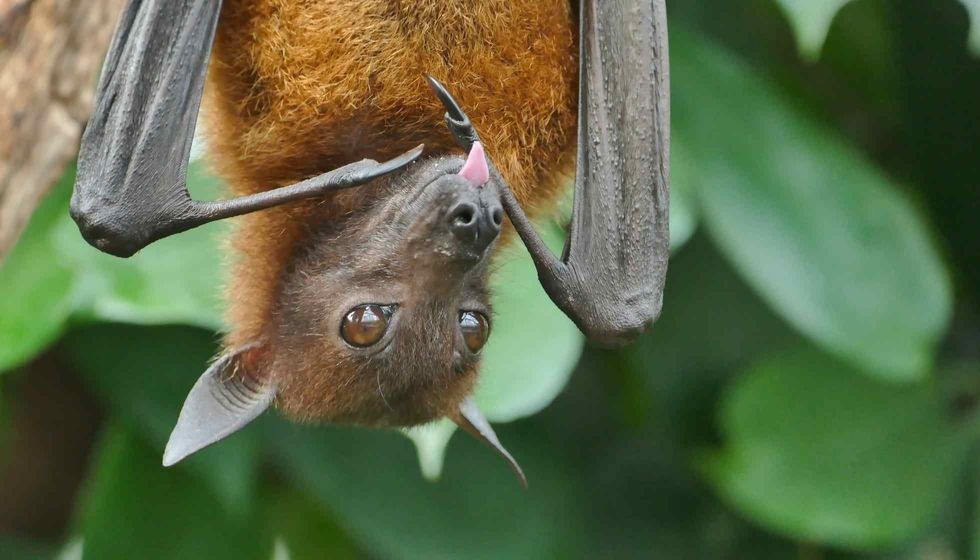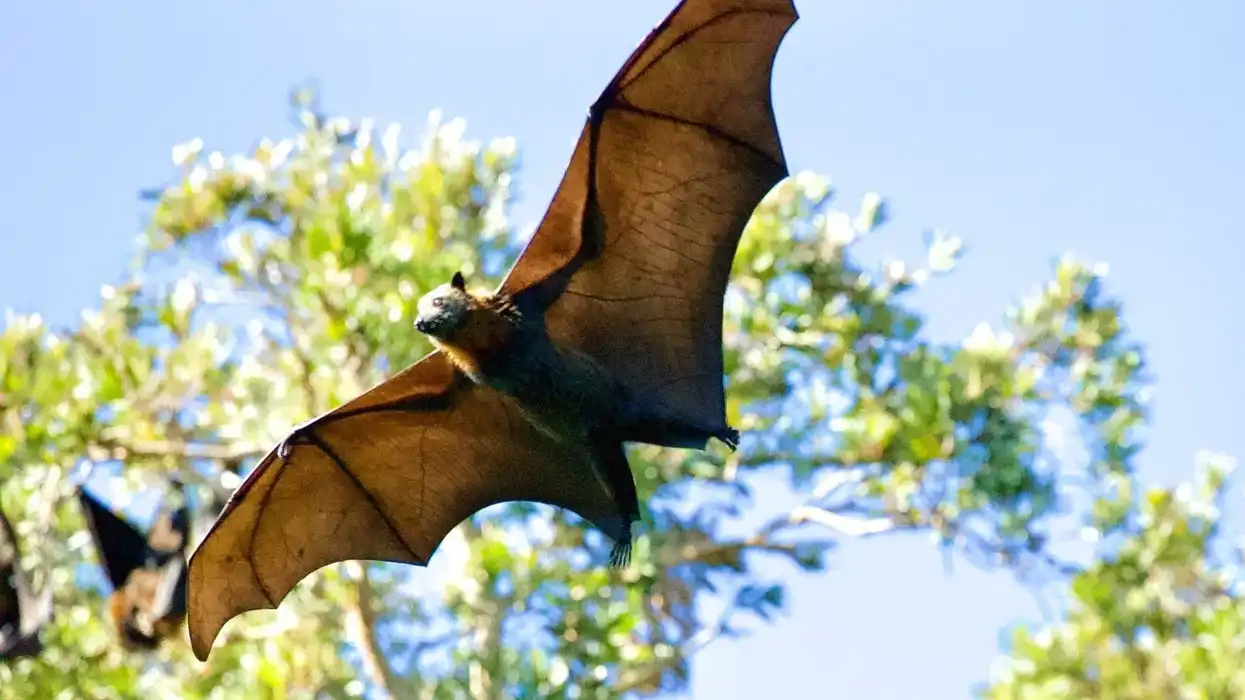The big brown bat, Eptesicus fuscus, is one of the largest Kentucky bats in the world. These bats have roundish ears. Their tail membrane, wing membranes, and ears are black in color and they have a brownish coating of fur on their body.
They have a wider nose compared to the size of their face. The basal metabolic rate of these bats changes seasonally, especially in pre and post-hibernation phases.
These animals prefer a large variety of habitats like deserts, cities, forests, and meadows. The bat roosts in areas like tree cavities, caves, tunnels, and similar areas. These animals feed on flying insects including moths, flies, flying ants, beetles, wasps, forest pests, and many more.
The mothers tend to feed on insects equal to their body weight while nursing the young ones. The babies are born with closed eyes and naked.
The mothers build a maternal colony to look after the young ones. During this period, they are completely dependent on their mother. These babies are often hunted by predators like snakes, raccoons from the maternity colonies.
The pups, when separated from their mother, make squeaking calls that can be heard at a distance of 30 ft from their source. The wingspan of these mammals is larger than the size of their body which enables them to fly.
They also use a technique called echolocation, with which they can locate obstacles, capture flying insects, and even locate predators.
Several articles and research work have been carried out by different universities, like the University of Michigan, and others to understand and study the behavior pattern of these animals. 'Journal of Mammalogy' studies the hibernation pattern of these animals.
Big brown bats are a very popular species of bat. To read more about this interesting animal and know interesting facts, continue below!
If you like our article on big brown bats, check out some of our other articles like common wombat facts and vampire bat facts.
Big Brown Bat Interesting Facts
What type of animal is a big brown bat?
Brown bats are a kind of bat.
What class of animal does a big brown bat belong to?
The brown bat, Eptesicus fuscus, belongs to the class Mammalia.
How many big brown bats are there in the world?
The exact number of these bats is not listed.
Where does a big brown bat live?
Big brown bats, Eptesicus fuscus, live in all sorts of places like deserts, forests, cities, and meadows. These bats roost in areas like caves, tunnels, and tree trunks.
What is a big brown bat habitat?
Big brown bats are found mainly in North America and Central America in countries like the United States of America, Canada, Brazil, the West Indies, and the Caribbean Islands.
Who does big brown bat live with?
The mothers form nursery colonies to take care of the young. They usually form roosting colonies to provide safety in numbers.
How long does a big brown bat live?
The lifespan of big brown bats can extend up to 20 years of age. However, the average lifespan of these bats is usually lower than this. The males tend to live longer than the females.
How do they reproduce?
These animals mate during fall or winter before they hibernate. During hibernation, the females store the sperms. During May usually, the females give birth to one or two pups. These babies are initially born blind and bare-skinned.
What is their conservation status?
The conservation status of the big brown bats isof Least Concern and they are of the lowest priority under the IUCN red list. They have a wide range of habitats and the population of these species is significantly higher than the other bat species.
Eastern America and the northern had a significant fall of the other species of the bats due to white-nose syndrome. It is a fungal disease that occurs in cold weather.
White-nose syndrome is responsible for causing a disturbance in their hibernation process.
It also results in a significant decrease in their body weight. However, that being said, the brown bats are resistant to the effects of this disease compared to the other species of the bat.
Big Brown Bat Fun Facts
What do big brown bats look like?

Big brown bats have copper, brownish-colored fur, while their belly area is a lighter shade. They have roundish ears and no fur on their face. Their ears, wings, and tail are black.
They have fleshy lips and their nose is slightly bigger compared to the size of their face. They have a total of 32 teeth, among which the upper incisors are larger than the lower ones. Their sharp teeth allow them to bite on hard substances.
Brown bats have bilateral symmetry and endothermic characteristics under physical features. Sexual dimorphism is also observed among these species. In this case, the females are slightly larger than the males.
How cute are they?
These bats are cute to look at. Their full lips and rounded ears only add to their adorable look. Their hairless black ears, wings, and tails add contrast to their copper-colored furry body.
How do they communicate?
Baby bats communicate with their mothers by continuous squeaking calls. In case the babies fall from the maternity colony or the winter roost, they produce sounds that can be heard at a distance of 30 ft from the source.
These bats can also communicate with each other through a lot of varied audible calls inside their roosts. They are known to produce sounds like hissing or squeaking. The flying bats also use echolocation to navigate.
How big is a big brown bat?
The adult big brown bats are usually 4.3-5.1 in (11-13 cm) in length. Their wingspan is about 12.8-13.8 in (32.5-35 cm) in length.
How fast can a big brown bat fly?
Big brown bats can fly at a speed of up to 40 mph (64.3 kph).
How much does a big brown bat weigh?
The body weight of these bats is around 0.5-0.9 oz (15-26 g).
What are their male and female names of the species?
There are no specific names allotted to the male and female bats.
What would you call a baby big brown bat?
The babies of big brown bats are called pups.
What do they eat?
These bat species are usually insectivores. Big brown bats feed on scarab beetles, cucumber beetles, ground beetles, flying insects, forest pests, lacewing flies, shieldworms, and corn rootworms.
Are they dangerous?
These bats, Eptesicus fuscus, have sharp teeth that can bite through skin. Some of these animals can carry rabies and can infect human beings.
Would they make a good pet?
These animals are not ideal to be kept as pets. Even though they are widely found in North and Central America, they do not do well in captivity.
Since the animals are migrating animals they do not survive for more than a year as pets. They prefer natural habitats like forests and roosting areas like caves. They are not appropriate to be kept as pets as it is illegal in many places to own bats as pets.
Did you know...
Big brown bats, Eptesicus fuscus, tend to return to their maternity roosts, especially the females. 72% of the females use these same maternity colonies for roosting the following year.
'Journal of Mammalogy' explores extensively the hibernation pattern of these Big Brown Bats. The University of Michigan is one among many universities that have explored this subject matter. One of the key contributors to this subject matter is Kathleen Berry.
These Bats have several hibernation sites during the winter season. The bats roost in tree cavities, rock crevices, caves, mines, tunnels, and many other places.
The big brown bat has a large wingspan whose length is much longer than the length of its body. They have a wide nose, compared to the size of their head. Their tail membrane and ears don't have any fur and are black in color.
These bats have some notable predators like snakes, raccoons, owls, weasels, and lots more.
The mother gives birth to one or two pups. They are born blind and their eyes remain closed. The babies stay completely dependent on the mother and remain in the maternity colonies.
Do big brown bats carry rabies?
Some big brown bats can have rabies. However, it is only on rare occasions. In most cases, despite carrying rabies, they generally do not affect human beings.
Here at Kidadl, we have carefully created lots of interesting family-friendly animal facts for everyone to discover! Learn more about some other mammals including rock hyrax facts and pronghorn facts.
You can even occupy yourself at home by coloring in one of our free printable big brown bat coloring pages.










